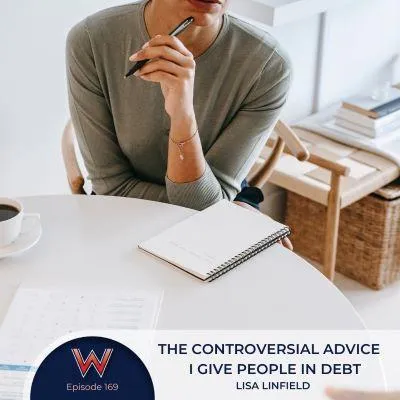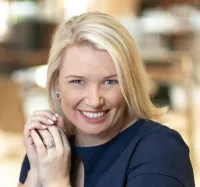Browse for the latest episode of...
working women's wealth

169 The controversial advice I give people in debt
Do you need help finding a way out of debt? There are a few ways to go about it, but here’s some controversial debt advice that might be useful to you...
Because you cannot be financially free when you are in debt, you need to make getting out of it a priority!
In this weeks episode I take you step by step through a couple of methods you could try to get out of, and STAY OUT OF debt. And in which instance it would be best to use which method.
Show notes:
[02.06] How to pay off your debt
[02.53] Minimum balance
[04.56] The Avalanche Method for debt reduction
[05.41] The Snowball Method for debt reduction
[08.34] Closing open tabs
[10.08] Removing Temptation
[11.17] Are there cases when I recommend Avalanche?
[15.01] Make sure you close the accounts – and then double make sure
Quotes
"You MUST pay the minimum balance on all your debts every month." - Lisa Linfield
"The real costs of debt often hide in the ‘lurking’ fees and expenses of debt accounts." - Lisa Linfield
"Everything we do in life either adds energy, or drains energy. And debt is an energy drain." - Lisa Linfield
"Kill the Debt… it truly is the only way to change the cycle." - Lisa Linfield
Subscribe to our podcast on iTunes or Spotify
Please do Subscribe to our Podcast on iTunes or Spotify and leave a review. This helps the podcast to rank higher and therefore makes it more visible to others browsing podcasts in the hope they too may benefit from our content.
Get my book - Deep Grooves: Overcoming Patterns that Keep you Stuck
You can get the first two chapters of my book FREE here
If you want a paperback copy and you’re in South Africa, visit my site LisaLinfield.com
If you want a Kindle copy or a paperback anywhere in the world, visit Amazon
TRANSCRIPT
Hello everyone and welcome to today’s episode of Working Women’s Wealth. I’m Lisa Linfield and I’m building a community of Women who are committed to the journey of living Financially Free lives – whether they’re just beginning, or nearly there, we support each other through our lessons learnt, good and bad, so ALL may benefit.
We’re in the middle of a journey on debt. In Episode 166, we looked at The Road to Poor – how the costs associated with debt meant that you ended up paying more than twice the price for the thing you bought. And it stands to reason, that if your living expenses are costing you double than the person who doesn’t use debt, that you’ll end up with less and less money. And all those extra fees you pay as well as the interest, means that you end up paying for the lenders to sit on the beach having nice holidays instead of you.
In Episode 167 – Removing the Roots of debt, we looked at the thinking that gets us into debt. Now I firmly believe that it doesn’t matter which 6 step plan you’re following to get out of debt, you’ll find yourself back in debt in no time if you don’t change your thinking. And with preparation, there are ways to prevent it happening, which we discussed in this episode.
How to pay off your debt
So today we’re going to do part 3 in the series – and focus on how to pay off your debt… and also ensure you stay out of debt.
There are two major ways to pay off debt, known as the snowball and the avalanche method.
One is in theory technically better than the other… but you know me so well by now, that you know that what is technically right on a spreadsheet or in a text book, is not always the best way behaviourally. And for me, getting stuff sorted is way more important than following the text book.
So let me tell you what the gurus will tell you.
Minimum balance
Firstly, regardless of which method of paying down debt you choose, the first principal is that you MUST pay the minimum balance on all your debts. That’s usually 2-2.5%.
The reason for this is that if you don’t pay the minimum balance, you’ll get hit with penalty fees – and as we discussed in The Road to Poor, Episode 166, penalty fees are extraordinarily expensive. So you end up multiplying your debt. And because the penalty fees just get added to your balance and the minimum payment goes to what you should have been paying in the first place, you then end up paying interest on those fees.
So step 1 is ALWAYS – pay the minimum amounts on all your debt!!!!!!
And to make sure that you do, get the company to set up an automated debit of however much that is – because the minimum payment will grow as your debt grows.
Just a side note on that – the minimum payment is the ABSOLUTE minimum. They love it when you pay that, because you’re underpaying what you need to pay to kill the debt. And growing the debt – which means you grow the amount you owe them and pay more fees and interest.
So you don’t want to pay only the minimum amount usually – but when you’re actively looking to pay off debt, you set all your debt payments to the minimum amount and redirect any extra you have to just one account.
The question is… which account do you pay first?
The Avalanche Method for debt reduction
Technically, the “right” way to pay your debt off is to take the debt with the highest interest rate first, and tackle that one.
The reason why is that not all rand or dollar of debt is equal. 100 of debt at a 20% interest rate means that in a year you’ll pay 20 of interest. But 100 of debt at 10% interest rate means that in a year you’ll pay only 10 of interest.
So the quicker you get rid of the highest interest rate debt, the more money you’ll have to put towards the lower interest rate debt.
And the spreadsheet will tell you that that is the best way to pay it off.
The Snowball Method for debt reduction
As you can probably tell already, without knowing your personal circumstances and therefore being able to advise on the correct one for you personally, I generally lean towards the Snowball Method of paying off debt. Let me first tell you about the method, and then I’ll tell you about why I choose it for most people.
The Snowball Method for debt reduction says that you line up your debts from smallest to largest, and you then pay off that little one first. Let’s say you were paying 100 towards it. Once it’s paid of, you take that 100 and pay it towards the next biggest debt – thereby overpaying the next debt by 100.
When you’ve finished that one, you take the first 100, the second debt’s 150, and now you overpay the third debt by 250 – and so it goes.
So, like the snowball picks up more and more snow and gets bigger and faster as it rolls down the hill, so your speed and size of payments get bigger and bigger as you close down accounts. Hence the snowball method.
So let me tell you why I prefer this method.
As we talked about in episode 166, the real costs of debt often hide in the ‘lurking’ fees and expenses of debt accounts. Monthly fees, compulsory insurance fees, automatic enrolment into the rewards program which you didn’t ask for but didn’t notice you’d been paying for the last 5 months.
So yes, technically, paying the highest interest helps. But if that highest interest rate has a balance of 5,000, and you have four little balances of 500, 1500 and 3000 (making together a 5,000 balance) – the monthly difference between their payments and the single 5,000 account payment may be 100 a month… but if the fees and extra charges on the three accounts together are 400 more – you may save on the interest payment but you lose on all the other expenses.
And that’s where ‘gurus’ go wrong. They do all these nice calculations on one small piece of the puzzle and forget the big picture.
The more open debt accounts you have, the more fees you pay – and the more chance you have of something going wrong and a payment not being made, and penalty fees being charged (before we talk of the negative credit score impact).
The other massive benefit of paying off your debt this way is that it closes some of the open tabs in your brain! Let me explain.
Closing open tabs
Everything we do in life adds energy, or drains energy. Debt is an energy drain.
Why? Because we know that we owe someone something, and that we have to pay it off. So its one more thing on our very long and stressful ‘to do’ list.
Now I don’t know about you, but every time my kids get hold of my phone or computer, they roll their eyes in disgust at how many open apps and open tabs within the apps I have going.
‘Mama!’ they say, ‘You cannot have this! It’s draining your battery energy and data in the background’.
‘But I’m not using them?’ I protest.
‘It doesn’t matter mama – any open tab drains energy in the background even though you don’t know about it’.
And every single debt is an energy draining open tab in your life.
And so when you squash the debt, you close an energy leak. And that makes you feel like you’re progressing, moving forward towards your debt free life. One less debt to worry about.
Removing Temptation
Another reason why I find it better, practically, to close as many open debt accounts as you can, is that it removes the temptation to add to your debt. If the account is closed, you can’t add to it.
And one of the biggest challenges we have to face in moving to a debt free life, is removing temptation. If it doesn’t exist, you can’t use it.
Just think about it – one of the first step alchoholics take is to throw or give away all their alcohol. So they don’t have the temptation of a bottle in their house when they’re feeling weak.
And you need to do the same.
Close down your opportunities to add to the debt. Remove the temptation.
Sure, like the alcoholic can go out and get hold of liquor – you could go out and open the account again. But, in both cases, it’s a lot bigger barrier to entry than it is if you have that card or bottle lying in your house.
Are there cases when I recommend Avalanche?
Yes, there are.
Every time I work with clients, their plan is different. A financial plan always works with you specifically and most importantly your money mindset and behaviour towards spending. So the real answer as to which I choose is in fact, ‘it depends’. But you have to have general guidance and step off the fence, so I’ve given you what to look out for to choose your own path.
The first case, is when debt is at ‘immoral’ interest rates. These are usually informal lenders, or ‘loan sharks’ as they’re known. And in that case, the debt can rise exponentially in a quick period of time. If you have interest rates of 10%, 12%, 17%, 25% and then one of 55% or more, then go with those. Or if those loan sharks are threatening your family.
Same goes if there are ‘immoral’ fees on an account. Then I would prioritise those.
The second case is when paying off that debt is key to your income. This often comes with trade credit, or finance on machines. If your income stream is in any way threatened, you need to prioritise those debts. Because if you can’t earn, you can’t pay anyone back. And then it all comes tumbling down.
The third case is when not paying a debt will result in your children getting kicked out of school, or your parents out of their old age home, or some other life or personal impact. Then, we may choose to prioritise those. But may not put the whole snowball towards them, but pay slightly over the minimum amount.
The last one is for highly analytical people who need a spreadsheet answer. Then we’ll work out exactly, with every single fee etc included what the real cost of the debt is, and do a highly technical answer – because for them, going against the spreadsheet causes more stress, and so closing tabs is not a high priority. But these people are not often in debt. Their spreadsheet mannerisms don’t allow them to be.
So if choosing a payment method of Snowball vs Avalanche is the second step, what’s the third step?
Make sure you close the accounts – and then double make sure
This is an extremely important piece of the puzzle. So many people think that once they finish paying off the debt, it’s done, they can move on.
DO NOT MOVE ON!!!!
Make sure you phone or go in person to close that account. Only once the account is closed, do the fees stop. An open account means that you may not be paying interest, but you will still be paying monthly fees.
And then, once the account is closed, you need to check the following month and the next month that no extra fees are added.
The amount of time I hear stories that start with, “I closed my account and then two years later couldn’t get a home loan because that account was now severely in debt. When I phoned, they said that the “xx” fee was always paid a month in arrears, so despite closing the account, that next month’s fee was still charged – and I’ve been paying penalty fees on that fee since then. And that’s ruined my credit score”.
So keep checking it’s closed. Either with the provider, or on a credit bureaux app.
Friends, you CANNOT live a life free of financial stress when you’re paying off debt. Even if you have to grit your teeth for a year or two and drastically cut your costs AND take on a side hustle, dig deep. The compounding effects of that big effort will reap benefits for years and decades to come. Kill the Debt… it truly is the only way to change the cycle.
In March I’m running my first pilot debt course… it will be taught live, in person via video conferencing, and will become the basis of other courses I will run around debt this year. It’s the year to Kill the Debt! Go to my website www.workingwomenswealth.com and sign up.
Have a good week friends, and please recommend this episode to someone you know who may need help finding a way out of debt.

Explore
On Social
YourBrand.com - All Rights Reserved - Terms & Conditions

